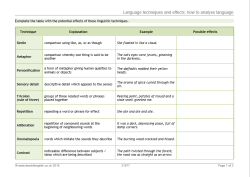Language techniques and effects: how to analyse
A detailed glossary-style resource to support GCSE English Language and GCSE English Literature students in their analysis of a range of literary and language techniques used by fiction and non-fiction writers. Students consider the possible effects of each of the techniques in terms of engaging the reader’s attention.
The teaching resource includes definitions of a range of literary devices to help English students when analysing a piece of writing or a literary work, including:
- metaphor
- simile
- personification (giving non-human or inanimate objects human characteristics)
- sensory details
- alliteration (repetition of consonant sounds)
- onomatopoeia.
There are accessible explanations of each of the nine literary techniques, with example quotations, and students are encouraged to make notes on the possible effects of the techniques in the reader’s mind.
There are also explanations of ten language features and language devices including:
- contrast
- repetition
- rhetorical questions
- emotive language
- word play
- sentence structure
- exaggeration (hyperbole)
- noticeable punctuation (such as ellipsis)
- powerful vocabulary
- tricolon (the rule of three).
Example devices from the resource:
|
Informal language |
casual, relaxed language e.g. slang, dialect and colloquialisms |
‘mate’, ‘aint’ and ‘nowt’ |
|
Alliteration |
repetition of consonant sounds at the beginning of neighbouring words |
It was a dark, depressing place, full of damp corners. |
|
Powerful vocabulary |
powerful or unusual verbs, adverbs, nouns or adjectives to describe actions or things. |
He charged ferociously into the pitch-black room. |
All reviews
Have you used this resource?
Review this resourcePossible Effects
Simile: Helps the reader to visualize ideas
Metaphor: Helps the reader to visualise ideas
Personification: Adds life-like effects
Sensory detail: Encourages the reader to imagine what is seen, smelt, heard, touched or felt.
Tricolon: Creates rhythm and emphasis.
Repetiton: Emphasises/ highlights/ reinforces ideas or feelings.
Alliteration: Draws attention to ideas or feelings. Slows the reader down. Increases pace / punch.
Onomatopoeia: Creates sound effects.
Contrasts: Highlights / emphasises / reinforces differences.
Powerful vocabulary: Influences how a reader reacts to ideas / adds impact / adds weight to ideas
Emotive language: Generates sympathy / other emotional reactions e.g. anger / shock.
Noticeable punctuation: Conveys a sense of pace / drama / emotion / suspense. Adds impact.
Sentence structure:
a) Adds a sense of urgency / drama / interruption or alters pace
b) Creates layers of detail / generates a sense of wandering / slows the reader
Exaggeration: Generates humour or sarcasm. Creates stronger reactions.
Informal language: Makes the text seem more natural and relaxed. Reflects character.
Rhetorical question: Encourages the reader to think or react. Involves the reader.
Unusual vocabulary: Presents ideas in a relevant, convincing or realistic way.
Symbolism: Triggers associations / suggests deeper underlying concepts
Wordplay: Provokes thought or amusement.
10/09/2019
29/08/2019
24/05/2019
14/05/2019
06/05/2019
20/02/2019
31/10/2018
19/10/2018
Once they write these sentences simply, it will be easy for them to understand how these techniques are used for effect.
18/10/2018
17/10/2018

